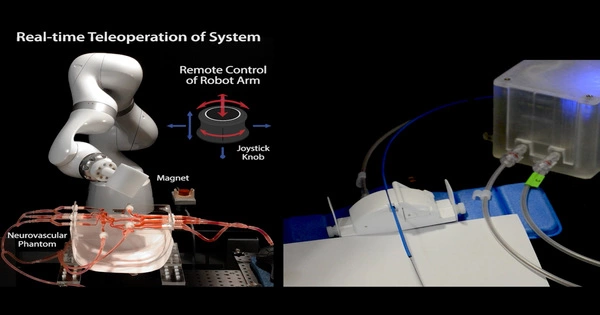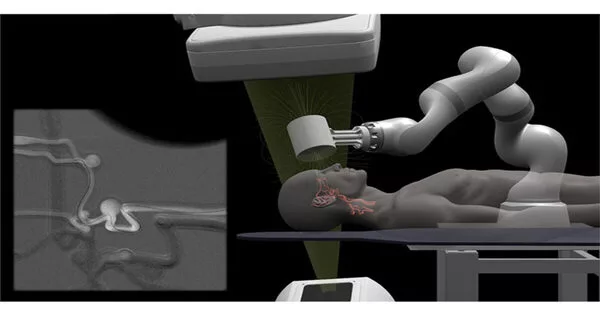MIT engineers have created a telerobotic system to assist surgeons in treating stroke or aneurysm patients rapidly and remotely. Surgeons at one hospital can use a customized joystick to control a robotic arm in another location, allowing them to safely operate on a patient during a critical window of time that could save their lives and preserve their brain function.
The robotic system, which moves thanks to magnets, is intended to help with endovascular intervention, which is a method used to treat strokes caused by blood clots in emergency cases. In most cases, a surgeon must manually guide a small wire to the clot, where it can either physically clear it or inject medications to break it up.
One drawback of such procedures is their accessibility: neurovascular surgeons are frequently based at large medical institutions that are difficult to reach for patients in rural areas, especially during the “golden hour,” the critical period following a stroke when treatment should be administered to minimize brain damage.
The MIT team hopes to have its robotic technology placed in smaller hospitals and overseen remotely by qualified surgeons in larger medical facilities. A medical-grade robotic arm with a magnet attached to its wrist is part of the system. An operator can control the magnet’s orientation and manipulate the arm using a joystick and live imaging to guide a soft and thin magnetic wire into arteries and vessels.

The method was exhibited in a “phantom,” a transparent device with vessels that replicated complicated brain arteries. After only an hour of training, neurosurgeons were able to remotely operate the robot’s arm and direct a wire through a maze of vessels to reach desired places in the model.
Instead of transferring a patient from a remote location to a large city, we believe they could go to a local hospital and have this system set up by nurses. In that golden hour, a neurosurgeon at a large medical facility might monitor live images of the patient and use the robot to operate. That is our ambition for the future, “MIT mechanical engineering and civil and environmental engineering professor Xuanhe Zhao agrees.
Zhao and his colleagues published their findings in the journal Science Robotics today. Yoonho Kim, Emily Genevriere, and Jaehun Choe of MIT are co-authors, as are Pablo Harker, Robert Regenhardt, Justin Vranic, Adam Dmytriw, and Aman Patel of Massachusetts General Hospital (MGH), as well as Marcin Balicki of Philips Research North America.
Tilt and twist
Endovascular surgery is a specialized, minimally invasive operation that includes twisting and guiding a thin medical wire through the body’s arteries and vessels to a specific area while avoiding damage to vessel walls. A surgeon normally needs years of training to master the technique.
In endovascular surgery, robotic systems are being investigated as assistive tools. In these devices, motor drivers advance and retract a wire while twisting it through the body’s vasculature.
“We imagine, instead of transporting a patient from a rural area to a large city, they could go to a local hospital where nurses could set up this system. A neurosurgeon at a major medical center could watch live imaging of the patient and use the robot to operate in that golden hour. That’s our future dream,”
Xuanhe Zhao, a professor of mechanical engineering and of civil and environmental engineering at MIT.
However, getting a robot to twist with the same amount of finesse as a surgeon does is difficult, Kim observes. “We use a fundamentally different mechanism in our system.”
The team’s new method expands on previous work, such as moving a magnetically controlled thread through a life-sized silicone model of the brain’s blood veins, which they exhibited in 2019. They did so with a handheld magnet the size of a soup can that they manually operated at the time.
They’ve since attached the magnet to the end of a medical-grade robotic arm that can be controlled using a mouse’s little joystick knob. Researchers can tilt the magnet in an orientation that a magnetic wire can follow by tilting the joystick. The mouse buttons operate a set of motorized linear motors that advance and retract the wire, allowing it to move forward and back.
With a soft, magnetically responsive tip that follows and bends in the direction of a magnetic field, the wire is as thin and flexible as a traditional neurovascular guidewire.
Finding a path
The robotic system was put to the test at the catheter lab at MGH, which is an operating room with typical medical imaging equipment for endovascular procedures. The robotic arm, as well as a life-sized silicone model of blood vessels, were put in the lab by the researchers. They placed the joystick in a control room, along with a monitor showing a live view of the model. After that, an operator watched the footage while remotely steering the wire through the boats with the joystick.
A group of neurosurgeons were trained to use the robotic device by the team. Each surgeon was able to correctly operate the device to guide the wire through intricate vessels that are difficult to travel with a manual guidewire after only one hour of training.
In the model, the team also employed the robotic device to clear artificial clots in hard-to-reach places. They maneuvered the guidewire through vessels and around tight bends and turns to reach areas where clots were simulated by the researchers. After successfully guiding the wire to the clot, the surgeons used typical endovascular techniques to insert a microcatheter along the wire to the clot’s location. They pulled the cable, leaving the catheter, which they used to successfully remove the clot.
“The magnetic guidewire’s primary goal is to go to the target spot swiftly and safely so that typical devices like microcatheters can deliver medicine,” Kim explains. “Our system functions as a compass.”
He expects that by using a teleoperated device, more patients will be able to obtain timely treatment. He also sees advantages for surgeons who perform vascular procedures in the same room as the patient while being subjected to X-ray imaging radiation.
Without recurrent exposure to X-rays, the neurosurgeons can operate the robot in another room or even in another city, Zhao explains. “Given that stroke is one of the main causes of death and long-term disability, we are extremely enthused about the potential impact of this technology on world health.”





